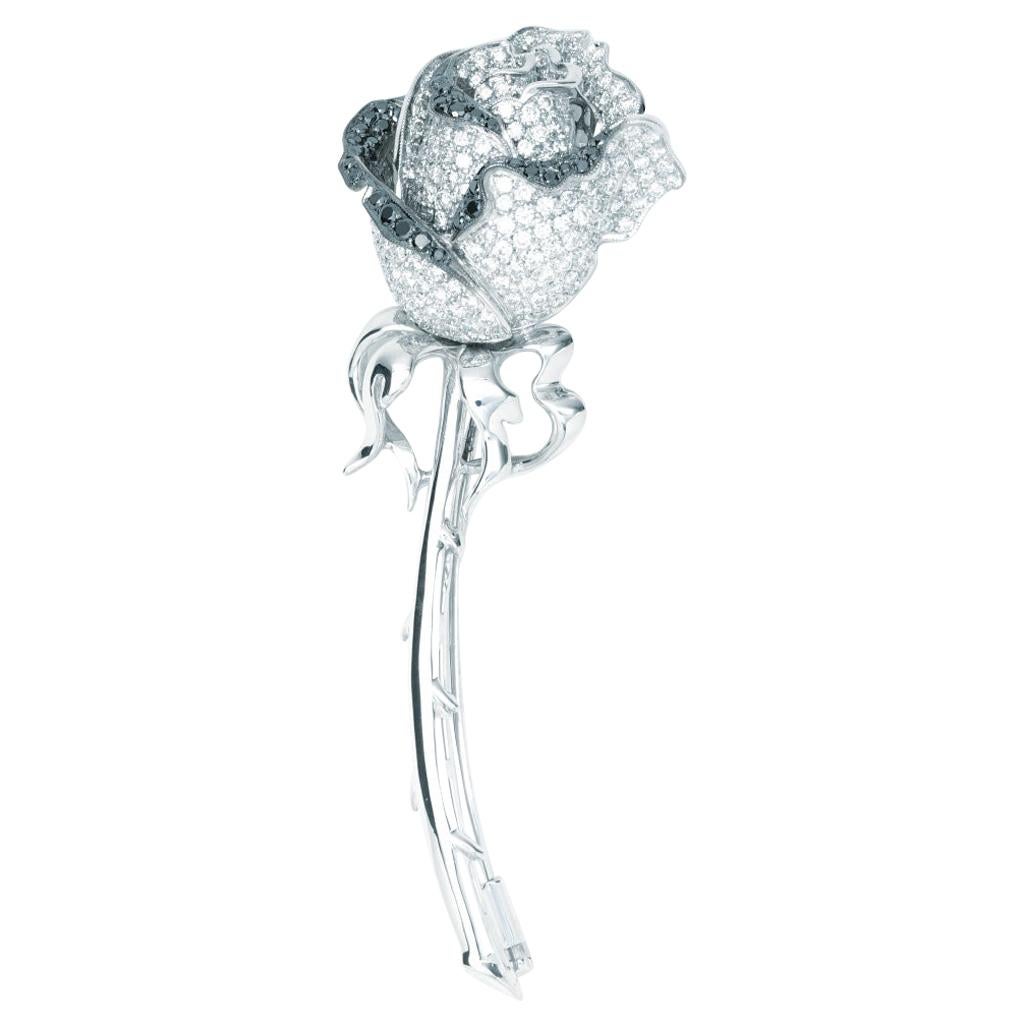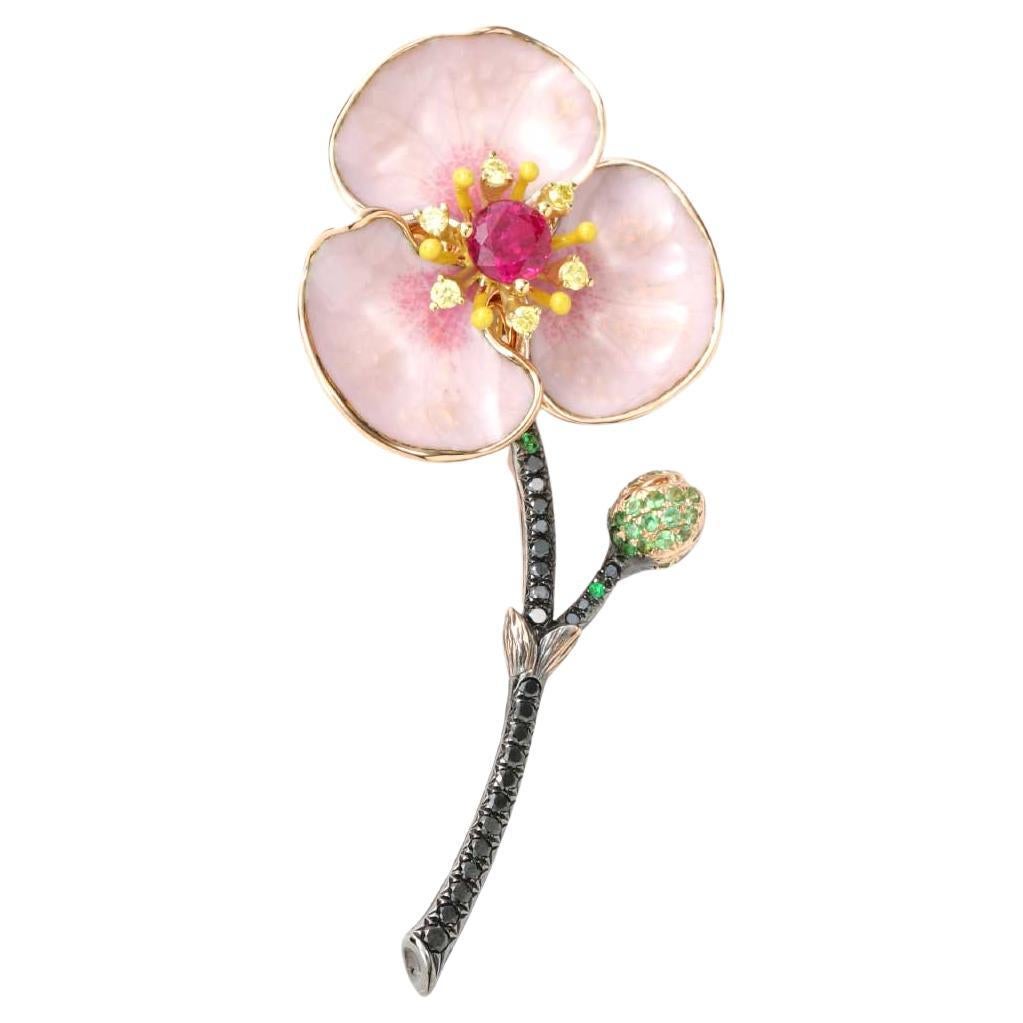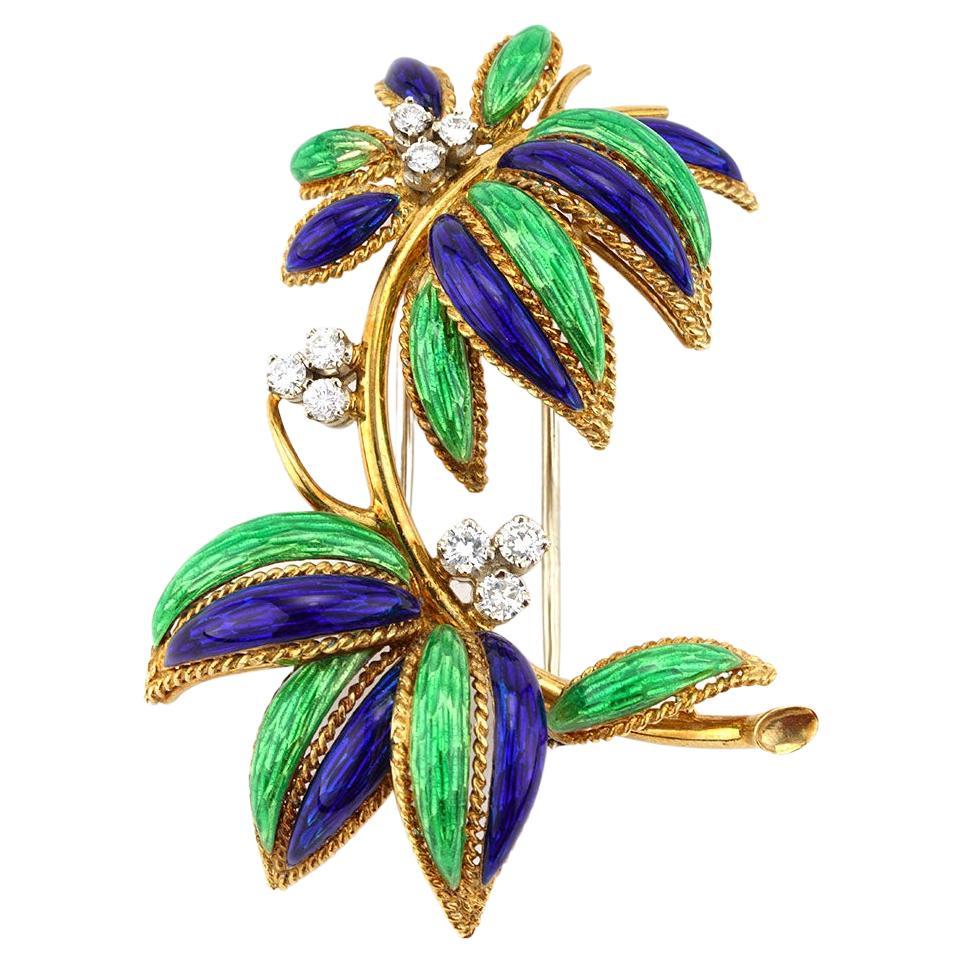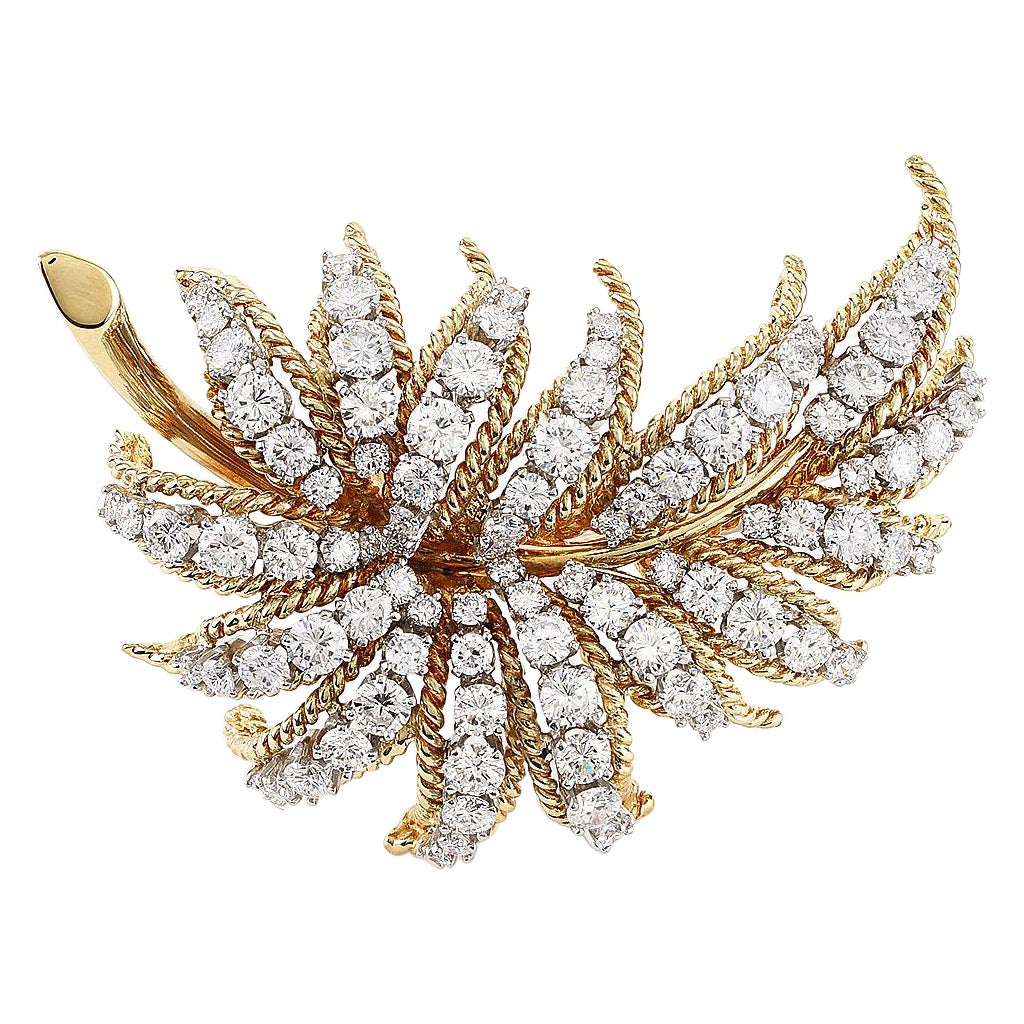Items Similar to Henry Schreiner 1930s ProngSetCrystal FloraSpray TeardropFrame GiltBrass Brooch
Want more images or videos?
Request additional images or videos from the seller
1 of 10
Henry Schreiner 1930s ProngSetCrystal FloraSpray TeardropFrame GiltBrass Brooch
About the Item
Henry Schreiner, the Austrian-born blacksmith founder of Schreiner New York in 1932, handcrafted this multi-color prong-set Bavarian crystal stylized-flora spray gold-gilt brass brooch before he began designing more extravagant silver-soldered settings in the early 1940s (see our other listing for the clear crystal demi-parure). Like the more linear and asymmetrical early pieces that can be distinguished as those clearly made by the founder, this elegant large brooch features sprawling overlapping wire arrangements with widely spaced soldered pre-cast settings that appear scattered and delicate like thin branches. The hand-arranged twisted wires are imperceptibly soldered on at least one end to his characteristic teardrop leaf-like frame without the need for rivet construction. He often assembled the metal strips of a frame sideways on an edge for added depth and shadows. More so, the hinge for the long pin and its safety clasp are neatly soldered to the edge of the central strip without an extra support bar. Further identifying the brooch, Schreiner's granddaughter published some family secrets about real Schreiners: "many of our flower pins, always have the end of the stem/wire hammered to flatten it." Comparatively, similarly styled handcrafted European brooches, such as some produced later by Countess Cis Zoltowska, have stems that are not hammered.
For some of the leading fashion designers since the mid-1930s such as American Norman Norell and French Christian Dior, Schreiner, who died in 1954, finished such custom-order pieces unsigned to accompany seasonal clothing ensembles in the tradition of European couture sets by Coco Chanel and Elsa Schiaparelli.
Most of the signed brooches produced after Schreiner's death under the direction of his late daughter Terry and her designer husband Ambros Albert included a versatile pendant hook for specially-made chains, layered hook-and-eye construction, unfoiled inverted stones, and were often mixed with uniquely elongated plastic or painted aurora-borealis glass jewels in a chunkier tighter arrangement, such as the popular ruffle design first produced in 1957.
In typical Schreiner style, the custom-made Czech rhinestones in six faceted shapes and colors--foiled cranberry, pink, green, lime, and white, plus unfoiled aqua--are positioned at different angles in three dimensions for maximum sparkle. Over time and use, only the clear crystals have darkened, while the brass has slight gilt loss where it was repeatedly handled such as on the pin.
Signed and unsigned Schreiner brooches with similar structure can be seen among the photos found in the co-authored book by Carole Tanenbaum and Eve Townsend, titled Schreiner: Masters of Twentieth-Century Costume Jewelry.
- Creator:
- Metal:Brass,Yellow Gold,Gilt Metal
- Stone:Crystal
- Stone Cut:Mixed Cut
- Weight:1.3 ounces (lb)
- Dimensions:Width: 3 in (76.2 mm)Depth: 1 in (25.4 mm)Length: 5 in (127 mm)
- Style:Artist
- Place of Origin:United States
- Period:1930-1939
- Date of Manufacture:late 1930s
- Condition:Wear consistent with age and use.
- Seller Location:Chicago, IL
- Reference Number:1stDibs: LU3244220994172
About the Seller
5.0
Vetted Seller
These experienced sellers undergo a comprehensive evaluation by our team of in-house experts.
Established in 2012
1stDibs seller since 2022
9 sales on 1stDibs
Typical response time: 1 hour
- ShippingRetrieving quote...Ships From: North Adams, MA
- Return PolicyA return for this item may be initiated within 1 day of delivery.
More From This SellerView All
- Cruciform NielloInlay FleurDeLys GiltEngravedCopperAlloy Heraldry Brooch PendantLocated in Chicago, ILThis 15th-Century period or older gilt copper and silver alloy amulet with niello inlay is an elaborately engraved three-dimensional brooch and pendant, which demonstrates the epitome of miniature decorative nielli in the early Renaissance by European goldsmiths of small cruciform or quatrefoil objects with heraldry symbols. Beyond a dense array of engraved radiant-light, cloud and star motifs with punchwork, it features a 10mm fine black crested staff that is the Christian symbol for the Holy Trinity. This intricate engraving with niello has fleur-de-lys elements, like a French or Florentine coat-of-arms or monogram used to identify noble families or a significant person like a king. It tops a 5mm bar, which is bracketed by 10mm peaked bars that form a cross. When worn, it is positioned horizontally like an elongated barbed quatrefoil. The bars may be concealing a relic such as wood, while it is not clear how these pieces are attached to the front. As a symbol of French conversion to Christianity, the French King Louis in the 12th Century made a fleur-de-lys element of the Holy Trinity vector the official emblem of his royal authority on shields. Later, English kings adopted it when claiming the French throne. By the 14th Century, the fleur-de-lys was used in family insignia that was sewn onto a knight's coat-of-mail surcoat. This coat-of-arms insignia could identify them if found on a battlefield. The Met Cloisters museum collection includes a similarly sized mid-15th Century French gold brooch...Category
Antique 15th Century and Earlier European Renaissance Brooches
MaterialsGilt Metal, Mixed Metal, Niello, Silver, Copper
- CoutureChanel Antique Byzantine ThePurpleHeart PearlAmethystQuartz GoldMedallionBy ChanelLocated in Chicago, ILDuring the ArtDeco period when Gabriel "Coco" Chanel was at her peak as a Parisian couture fashion-designer in the early 1930s, this antique one-of-a-kind handcrafted gem-fringed and gilt-chain medallion brooch with trombone clasp was commissioned to accessorize one of her clothing designs. Marked only "FRANCE" like some early 1930s Chanel couture jewelry (without a brand stamp until the 1950s), its artistic origin is most likely from ornate organic-form sketches by her favorite parurer Fulco di Verdura. The Sicilian duke began creating fabric patterns for Chanel in 1927, which shortly expanded to fine jewelry beginning with custom pieces for herself. These include the iconic Byzantine-influenced gem-adorned cuffs referencing the Maltese military-cross, which the French designer can often be seen wearing in circa-1930s photos. This bright yellow-gold brooch suits goldsmith Verdura's early anti-Art-Deco aesthetic that was considered a radical departure from 1920s silver-tone jewelry, which otherwise featured linear geometric designs or figurative representation. The softly-shaped deconstructed gem-bouquet mixes amethyst and rose-quartz beads with natural Keshi pearls and intricate tiny gilt leaves, which are wired to a Baroque-motif open-work frame that dangles another gem surrounded by a thick gilt-rope halo. Notably, Verdura is credited with re-introducing since Victorian times the rope motif to jewelry. Since 1930, Verdura's unique style was influenced by travels with Chanel to explore Byzantine art, Baroque architecture, and exotic flora-and-fauna among his native Italian aristocratic estate. The legendary fashion-editor Diane Vreeland and American entertainment-stars were among the first Chanel clients to acquire couture real-gem-adorned jewelry made by Verdura, while one of the two brooches treasured by Vreeland was titled "Theodora". See our photo of the Byzantine mosaic of Empress Theodora, whose image wearing many teardrop pearls above her chest and surrounded by a golden halo seems to be the inspiration for this brooch. As one of the most important modern-design collaborations, Chanel's close relationship with Verdura lasted largely-undocumented years in Paris, until he launched his first outside jewelry venture with a Hollywood designer-boutique after emigrating to the United States in 1934. By 1939 as a financially-backed in-demand goldsmith, he founded the namesake jewelry-company Verdura in NYC. After he retired in 1973, the brand continued to operate without him with different owners. Given the duo's designs that played with historic and military references, Chanel's couture commission for this purple medallion may have been sparked in the early 1930s when the internationally-new...Category
Vintage 1930s French Byzantine Brooches
MaterialsAmethyst, Pearl, Quartz, Gold, Gilt Metal, Yellow Gold
- Couture 1930s CocoChanel LinaBaretti SatinBlackCamellias PaveCrystals Gold SetBy ChanelLocated in Chicago, ILThis rare signed couture set of pave-crystal and gold-plated brooch and earrings from the Art Deco period is marked in the manner of one-off costume jewelry commissioned...Category
Vintage 1930s French Art Deco Brooches
MaterialsCrystal, Gold, Gold Plate, Silver
- Swedish 1962 Tennesmed SterlingSilver RedPouredGlass Geometric Stigbert BroochBy Rune TennesmedLocated in Chicago, ILMade in 1962 by Swedish Rune Tennesmed, this modern minimal sterling silver geometric brooch features a faux ruby poured-glass red cabochon, concave sheet metal, and openwork that forms two corners of the two-tier triangular brooch. This simple abstract design is characteristic of the rounded geometric shapes that framed his silvery pieces, while his early work sometimes included a pop of brightly colored glass. Tennesmed (1929-2011) was a 20th-century studio metalsmith, who changed his given name Carlsson to reflect his craft and his business name, which means "pewtersmith" in Swedish. This unusually elegant and sleek piece was made for Scandinavian Atelie Stigbert, which was recognized for producing modern jewelry designs in sterling silver and gold. The brooch was likely commissioned by the Stigbert workshop founder Stig Engelbert who died in 1962, before his artisan sons evolved the family business to be known as Engelbert. Recognized as one of the most significant and popular Scandinavian artists of the mid-20th century, Tennesmed revived ancient Viking...Category
Vintage 1960s Swedish Modernist Brooches
MaterialsRuby, Sterling Silver
- Artist 1950s Modern Sterling Set OpenworkLeaves RebajesProtege Earrings & BroochBy Artistian MadeLocated in Chicago, ILThis mid-century modern-art sterling-silver openwork stylized-leaves set of brooch and screw-back earrings was handcrafted by metalsmith Otto Robert Bade (1921-2019). His distinct wo...Category
Mid-20th Century American Modernist Brooches
MaterialsSterling Silver
- Artist BertoiaStyle Hammered SterlingSilver SquiggleSpiral UndulatingWire BroochLocated in Chicago, ILThis modern mid-century abstract three-dimensional unsigned brooch is a single hand-hammered sterling-silver wire that was shaped by an artist into an undulating squiggle that ends i...Category
Early 20th Century American Modern Brooches
MaterialsSterling Silver
You May Also Like
- Le Vian Black and White Diamond Rose Pin White GoldBy Le VianLocated in Chicago, ILPreviously-owned Levian Black and White Diamond Rose Collection pin. The pin is 3 inches in length, made of 18K white gold, and weighs 12.70 DWT (approx. 19.75 grams). It also has 37...Category
Early 2000s Unknown Brooches
MaterialsDiamond, Black Diamond, 18k Gold
- Art Deco 1.20 CTTW Pearl, Ruby, And Emerald Pin Brooch In 14K Yellow GoldLocated in Chicago, ILThis pearl, ruby, and emerald pin is made of 14K yellow gold. It contains a round white pearl , round green emeralds weighing 0.50 CTTW, and round red rubies weighing 0.70 CTTW.Category
Mid-20th Century Art Deco Brooches
MaterialsEmerald, Pearl, Ruby, 14k Gold, Yellow Gold
- Diamond, Ruby, Tsavorite And Enamel Flower Pin In Multi Tone GoldLocated in Chicago, ILThis Enamel pin is made of 18k Rose Gold . It contains a round ruby weighing 0.55 CT, round green tsavorites weighing 0.32 CTTW, round multi color, diamonds weighing 0.31 CTTW, round...Category
Late 20th Century Art Nouveau Brooches
MaterialsDiamond, Ruby, Tsavorite, Gold, Enamel
- Blue And Green Enamel And Diamond Tree Motif Pin In Yellow GoldLocated in Chicago, ILThis tree motif pin weighs 15.20 DWT (approx. 23.64 grams). It contains 9 round G color and VS clarity diamonds weighing 0.60 CTTW.Category
Late 20th Century Art Nouveau Brooches
MaterialsDiamond, Yellow Gold, Enamel
- Tiffany & Co. Vintage 18 Karat Yellow Gold and Blue Sapphire Brooch, circa 1960By Tiffany & Co.Located in Chicago, ILThe brooch is 24mm wide, 2.25 inches in length, made of 18K yellow gold, and weighs 6.40 DWT (approx. 9.95 grams). It also has seven round sapphires.Category
Vintage 1960s American Retro Brooches
MaterialsBlue Sapphire, 18k Gold
- 6.50 CTTW Diamond Leaf Style Pin in Yellow GoldLocated in Chicago, ILThis vintage style pin is made of 18k yellow gold and weighs 15.00 DWT (approx. 23.33 grams). It contains 93 round G color and VS clarity diamonds w...Category
Mid-20th Century Art Deco Brooches
MaterialsDiamond, 18k Gold, Yellow Gold
Recently Viewed
View AllMore Ways To Browse
Chanel Plastic Chain
Chanel Chain Frame
Large Set Of Pendants With Clear Glass
Schreiner Ruffle
Schreiner Ruffle Brooch
Green Coco Handle
Clear Stone Brooch
Vintage Rhinestone Leaf Brooch
Chanel Coco Bar
Vintage Crystal Flower Brooches
Czech Glass Brooch
Vintage Rhinestone Brooch Set
Chanel Brooch With Rhinestone
3d Flower Brooch
Rhodolite Garnet Brooch
Diamond And Pearl Circular Brooch
Antique Scottish Silver Cross
Christian Dior Brooch 19





